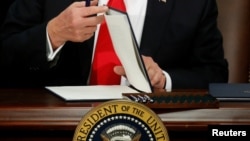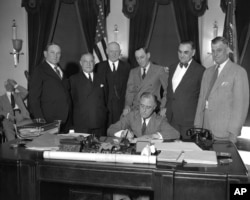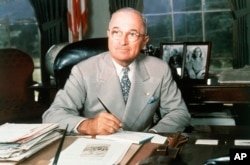The first week of Donald Trump's presidency has seen him sign a number of documents setting out policy on issues ranging from the rollback of the Affordable Care Act to removing the United States from the multinational trade agreement known as the Trans-Pacific Partnership.
Some of these documents have come in the form of executive orders, and some as White House memoranda. What's the difference? What kind of power do they carry, and what are some of the most famous?
Executive orders vs. memoranda
First things first: both have what is known as the "force of law," which means they have the same power as legislation passed by both houses of Congress and signed by the president.
Subtle differences
- Executive orders are numbered and published in the Federal Register, the official journal of the United States government; memoranda need not be published there.
- Executive orders must also indicate the price of executing the order; memoranda do not require a price tag unless they exceed $100 million.
Most notable
Every U.S. president except one (William Henry Harrison) has issued executive orders and memoranda, from George Washington all the way up to President Trump.
Franklin Delano Roosevelt (FDR), the only president who served more than two terms, also issued the most executive orders, a whopping 3,721 of them, most regarding measures to combat the Great Depression and U.S. actions during World War Two.
Some executive orders have literally changed history, for better or worse. Here are a few of the most famous:
The Emancipation Proclamation:
President Abraham Lincoln issued the Emancipation Proclamation on January 1, 1863. It freed all slaves living in the Confederacy during the Civil War. Since the southern states had seceded from the Union, the proclamation had little effect initially other than to ensure the freedom of any slaves who escaped to the northern states.
The New Deal:
In the midst of the Great Depression, FDR issued many executive orders designed to get jobless Americans working again. During the winter of 1933, he established the Civil Works Administration, which created 4 million new government jobs. He also used his presidential authority to create the Export/Import Bank, and in 1934, the Rural Electrification Administration, which brought electricity to remote parts of the country.
Japanese-American Internment:
After the Japanese attack on Pearl Harbor in Hawaii in 1941, FDR signed Executive Order 9066, which allowed military leaders to designate strategic parts of the country as "military areas ... from which any or all persons may be excluded."
It also gave the military the responsibility to "provide for residents ... who are excluded ... such transportation, food, shelter, and other accommodations as may be necessary."
The result was that 120,000 men, women and children, most of them American citizens of Japanese descent, were deported from the U.S. West Coast and placed in internment camps between 1942 and 1945.
Desegregation of the Military
In 1948, three years after the end of World War II, President Harry Truman signed Executive Order 9981, which officially desegregated the United States military.
The order was a simple statement: "There shall be equality of treatment and opportunity for all persons in the Armed Services without regard to race, color, religion or national origin."
Up until that point, military units were segregated by race; soldiers trained, worked and even fought in groups separated by race.
Sign of the times
Very few of the thousands of executive orders and memoranda that have been issued are as momentous as the ones listed here. Some of them express the frustration of a president facing a hostile Congress unwilling to pass legislation. Others are expressions of issues of great topical importance. Together they offer an insight into American history and reflect the priorities of each president and the times in which he served.
































